WHOA! Where’d that sign post come from? Fear in dogs needs tending to but if you don’t know how to read dogs you won’t know if they are afraid, cautious, excited or what; therefore, you won’t know how to help to them.
Although we walked this same trail yesterday, today this sign post became a monster. SADIE, my new charge in training is a 10 month old Golden Retriever who came from a very loving home yet didn’t get out to see the world much. Her guardian got seriously ill, leaving Sadie not to be properly socialized, during critical periods of her puppyhood.

Sadie, on our way home, our first day together. Unfamiliar with a car, you can see she’s a bit fearful. Rounded boys, panting, hiding (staying in the corner), ears down and sideways.
The lack of exposure in her life for her first 10 months had SADIE be very cautious of everything around her. Noises, like the coffee grinder made her jump, new people had her very tentative and the same went with new dogs. Some people would have said she was fearful but it wasn’t fear at all. SADIE wasn’t afraid of the noises, people and dogs, she was tentative or more accurately, cautious. There is a tremendous difference in the two and why I’m writing this blog. Very often these body languages are confusing and misread therefore, misinterpreted which translates to inaccurate guidance to help the dog.
SADIE wasn’t afraid of the sign post, she was in overwhelm with this brand new world that held smells like she’s never smelled before, sights that were just too much to take in, sounds of nature, people talking, dogs barking… everything coming at her at once was just too overwhelming, so as she began to actually look around her, new things would strike her attention… ‘WHAT IS THAT?’ was her response as she stood frozen in place. The trail that I hike on is actually very quiet with few people or dogs, hiking only during the week when it’s less populated. I hike with my dogs, so they can be her teachers, and Sadie, following them around like glue. Still it was a lot to take in, so occasionally, she would stop dead in her tracks wondering what this or that was.
The difference in a dog who’s displaying caution is quite different than that of a dog who’s displaying fear.
The next images are from the Dog Decoder smartphone app about dog body language. Each scenario has three parts to it. The Pose, Information about the pose and finally Details: telling which body parts are talking.
CAUTION
Pose
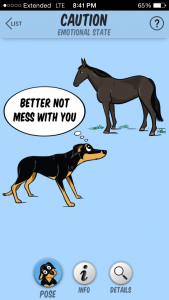
Info
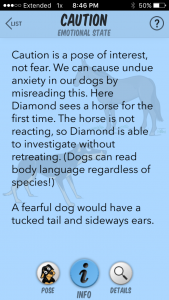
Details

FEAR
Pose
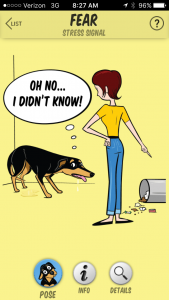
Info
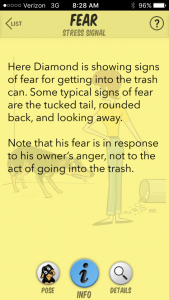
Details
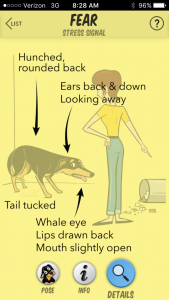
The body posture is the most obvious in both of these poses, but the more subtle ones are the ears, look away, head lowered, tail tucked, (not just down), panting and open mouth. Look at both images again, to note the differences between caution and fear.
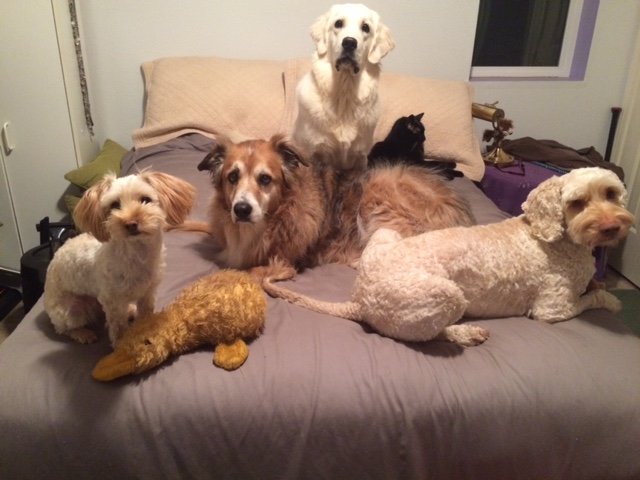
Sadie, after a couple of weeks with me and my dogs as her teachers. Body languages to see are alert ears, direct eye contact, upright enthusiastic body posture, closed mouth.
Helping dogs who are cautions is about small sessions of exposure to life. Having a solid dog as a teacher helps tremendously. If you don’t have a teacher dog, try to find one. It makes it much easier for them, making the duration of shorter. It’s ok, if you don’t have a teacher dog, you’ll proceed in the same manner, keeping exposure sessions short and rewarding lavishly with high value food treats. Using food to pair whatever they are cautions of helps change the association of one of caution to relaxed and more curious.
Helping dogs who are fearful needs to be done slowly as well, yet the biggest difference, I feel is to move away from the feared person, dog, object while pairing with a high value treat, and only moving closer when the dog feels safe. This takes longer if the dog is too afraid. It may even take multiple sessions to overcome some fears. This could take days, weeks, months or even years in some serious cases. Great teacher dogs will help, too. But if you do use a teacher dog, you must be very savvy about managing both dogs to keep the fearful dog under threshold. Be sure not to overwhelm a fearful dog. Short sessions over time work best. Short sessions may be 30 seconds for dogs who are very afraid, gradually increasing the time, making sure never to let the dog go over threshold. Some people think, just exposing a dog to his fears is the best way to go and this couldn’t be farther from the truth. I’m petrified of snakes and if someone made me face that fear by putting me in a room of snakes, I’m sorry, but I’d high tail it out of there and never come back. I have no desire to overcome my fear of snakes. With this in mind, there are some fears that dogs have that we never need to address because doing so isn’t in the best interest of the dog. One of these situations is if a dog has a fear of horses, for whatever reason and we don’t have horses, then there is no real reason for the dog to overcome her fear. Look at your lifestyle with your dog and if there are things you need to tend to, by all means, do so. If they’re not, there are so many other things you can be working on with your dog, so do those things.
When reading dog body language one must take into account the context of what is happening, while assessing the body parts talking, in order to properly interpret what the dog is trying to say. This way you will be more apt to help the dog out with the proper guidance to make her feel more secure.
Learning to speak dog is crucial if you want a true bond with your dog. You can’t bond if you can’t communicate.
About the author: Jill Breitner, is a professional dog trainer, award winning author and dog body language expert loving, living her life on the west coast of the USA. She is the author of Dog Decoder, a smartphone app about dog body language recommended and used by veterinarians, shelters, trainers, educators and guardians worldwide. Dog Decoder is available in iTunes and Google play. Jill has been teaching gentle handling/basic husbandry skills to clients and their dogs for 40 years, to be your pets advocate for a happier and stress free life. She also does online dog training, worldwide. Join Jill on her Dog Decoder Facebook page


